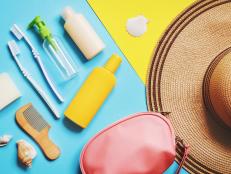World Cup Memories and Travel Tips
Washington Post reporter Steven Goff shares a few insights from his many years of attending soccer's premier tournament.


Pedro Vilela/Getty Images
“When you hear the FIFA anthem and the team’s march out, you really begin to appreciate where you are and the opportunity that has been given to you.”
Those are the words of Washington Post reporter Steven Goff who has covered every FIFA World Cup since 1994. He’s traveled to over two dozen countries writing about the beautiful game and over the years, has witnessed some of the most iconic moments in World Cup history. This summer, Goff is once again packing his bags and heading to the quadrennial tournament, which kicks off on June 14 in Russia.
Before boarding a flight to Moscow though, we caught up with Goff to ask him about his packing preparation, privacy concerns in Russia and what souvenirs he hopes to bring back.
Moscow's Must-See Sights
See All PhotosYou’ve been to six World Cups, is there one that stands out as being more memorable than the others?
I always say the best ones were Germany (2006) and France (1998) because of the size of the countries. Logistically it was easiest and the passion for the sport was at its highest, especially in Germany.
The one that was most memorable for me was South Africa (2010). It was in isolation for so long. The world got to see South Africa through the World Cup. The culture, the politics, the racial dynamics, the geography, everything was eye-opening. That one left the most lasting memories.
Europe's Must-Visit Soccer Stadiums
See All PhotosDescribe the atmosphere in and around the stadium on match day. How does a city transform for the match?
Every city is different. The bigger cities have a lot going on, so they’re not as consumed by the tournament or game, but you still feel it.
Every country and venue is a little bit different too. One that stands out to me is Kaiserslautern, Germany. It’s not a big city and the stadium is on a hill so you have people in the city center and as the game approaches, they make their way upward to the stadium.
Durban, South Africa, is on the Indian Ocean and the stadium is a couple hundred yards from the shore, so there’s a lot of activity on the beach and seaside cafes before the game.
Brazil was special in its own way because of the history of the game. I was in the jungle, in Manaus, where it was 90 degrees with 99 percent humidity. That was a unique experience.

2010 FIFA World Cup Organising Committee South Africa via Getty Images
Which nation has the most passionate fans?
I love the French national anthem. It gives you goosebumps when you hear that song and people singing along. England certainly get into the game as well. The Dutch are very passionate. It will be exciting to see Iceland for the first time and the incredible passion of their supporters.
How far in advance do you start preparing for the trip to the World Cup?
Things get serious after the draw, so about six months out. That’s when you find out who’s playing in which cities and where you need to be and where you can get to. For this World Cup, the draw took place in early December and within a few days I bought my plane ticket. I’m different though, I know I’m going to be there while fans are still waiting to see if they will receive a ticket so it’s hard to plan too far in advance.
How much research did you do for a trip to Russia?
The Washington Post’s coverage plan dictated that I would be mostly based in Moscow. There are 11 venues overall, Moscow is one, but it’s the only one that uses two different stadiums so the most games are taking place there. Plus, if you need to get a flight or train to another city you have to go through there anyway.
I’ve never been to Moscow, so I didn’t know what to expect. I researched and found out that a few blocks from my apartment is a Shake Shack! It’s a small world.
World Cup Destinations 18 Photos
Here's a look at the countries that will host the FIFA Women's World Cup matches in 2019 and the FIFA Men's World Cup matches in 2018 and 2022.
I’ve registered with the U.S. Department of State and got my visa. For work purposes, our IT department has special instructions with our mobile phones and laptops. You go into it with the assumption that nothing is private.
I always do a little homework to see what’s readily available. Things like batteries, chargers, power adapters. Do your homework in terms of the weather. Moscow is a little north, St. Petersburg is particularly north. Also, research about the culture. Do people wear shorts? Is that common? Certainly, going to Qatar in 2022 for the World Cup there’s much more preparation due to cultural differences. Russia not so much.
What do you usually pack in your bag for a World Cup trip? Any packing hacks you can share?

I try not to bring too much stuff. So much is on your phone now. I’m usually there for a long time and I bounce around cities, so I don’t like to drag around a lot of stuff.
The World Cup is an outdoor event so you’ll end up doing a lot of walking. You’ll end up on a lot of shuttle buses. There are beer gardens, street festivals and fan fests with big televisions. It’s a good time and you don’t need to bring much.
The World Cup in South Africa was during their winter (summer for us), so it was cold and I had a lot of winter material. I used bags that I could suck the air out of to compress everything to create more space in my suitcase. I use a lot of dry cleaner bags to keep shirts from wrinkling. Turning a blazer inside out I find helps limit wrinkles. I also bring medication in the original bottle. I’ve never had an issue but you don’t want to have loose pills on you.
What souvenir do you have your eye on?
I’m a big collector of pins. They’re easy to carry around. You can pick one up early in the tournament and you don’t have to drag it around with you. I also collect all of the tickets from the games. Scarves are big, too. I occasionally pick up some of those. I’ll look for unique things like in South Africa the Vuvuzela. I’ll also get the original World Cup poster and have it framed.

Simon Bruty/Getty Images
Who is going to win this year?
I’ll go with Germany. France is definitely a contender. Brazil will be very good.


































.jpg.rend.hgtvcom.231.174.suffix/1674758726773.jpeg)











